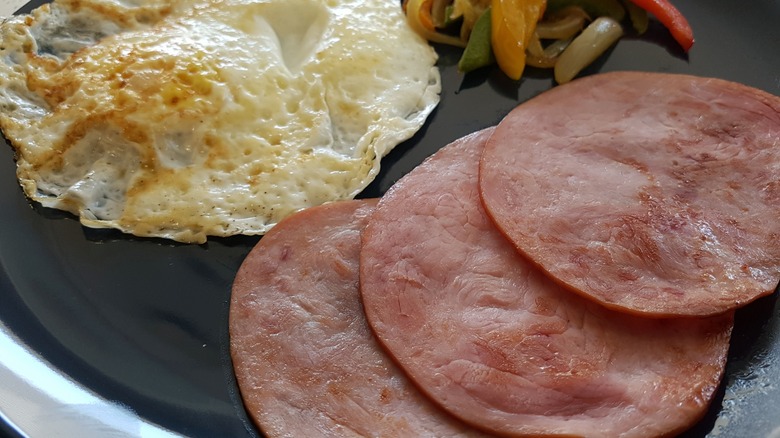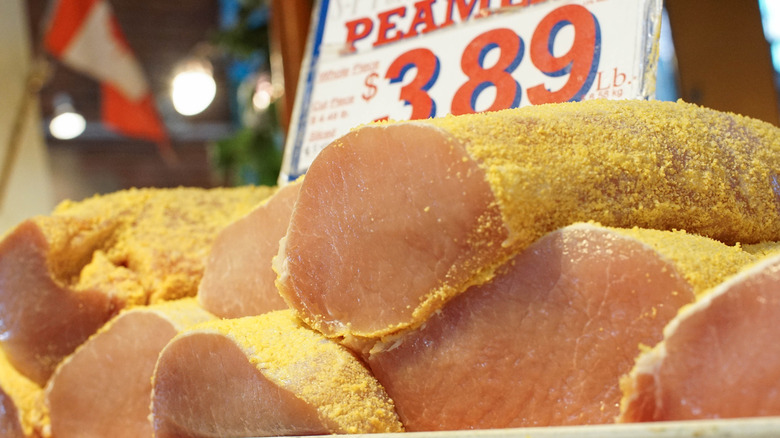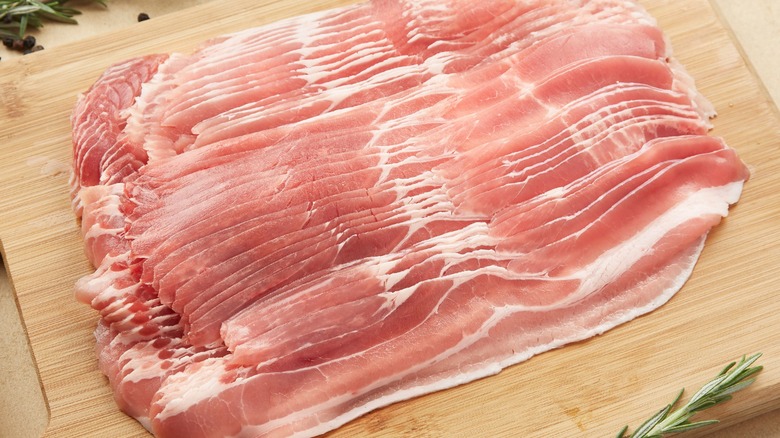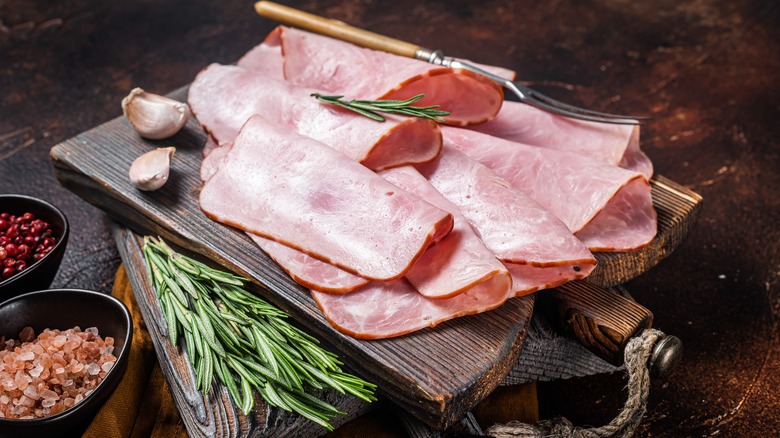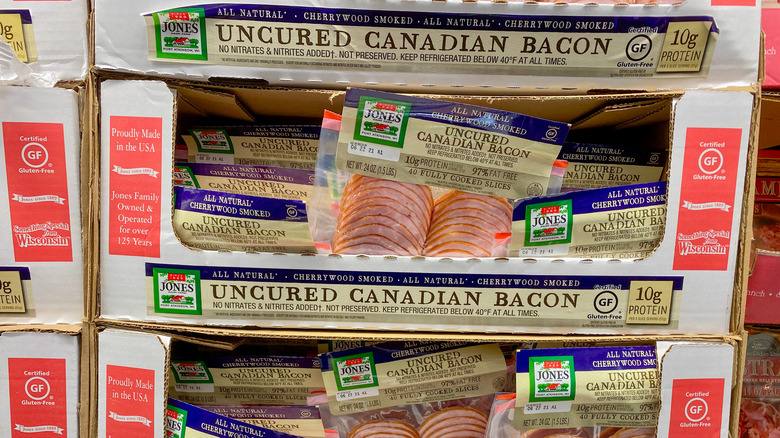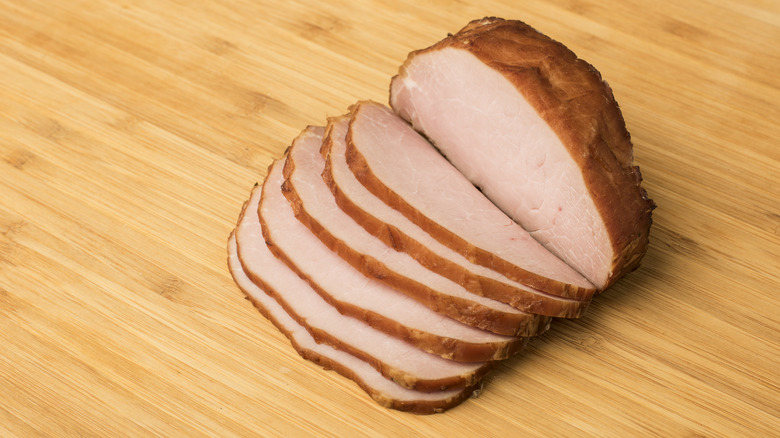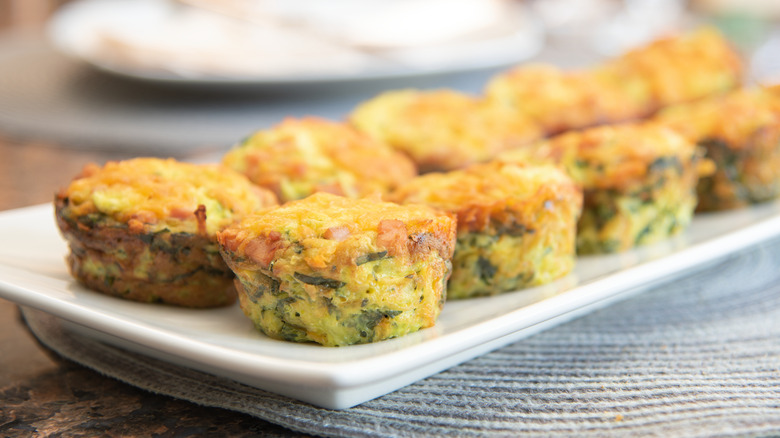Facts You Should Master About Canadian Bacon
You know it as that delicious little piece of meat on your Egg McMuffin or as an ingredient listed in your favorite eggs benedict recipe. Sometimes you'll find Canadian bacon on your pizza. Maybe you prepare it occasionally at home. Some home cooks go beyond the sophisticated breakfast dish to mix this ingredient into comfort-style egg casseroles or frittatas. But how much do you really know about Canadian bacon?
This somewhat misnamed bacon is not really from Canada and isn't actually all that close to your traditional American bacon. In fact, ask for it north of the border, and you'll not get the same thing you would in the United States. Lean, ready to eat straight from the package (though you might want to warm it first), and oh-so-tasty, Canadian bacon is arguably unique and almost definitely underutilized. However, currently underused or not, if you learn just a little bit more about this breakfast meat, you might just find it becomes an irreplaceable staple in your kitchen. Here's everything you need to know about Canadian bacon.
1. The origins of Canadian bacon
One would assume that Canadian bacon hails from Canada, but that's not actually the case. As a Pittsburgh Post Gazette columnist wrote, Canadian bacon in the United States is different from Canadian bacon in Canada, and if you tried to find your standard Egg McMuffin-style Canadian bacon in a grocery store in someplace like Ontario or Quebec, alongside other iconic Canadian foods, you would be sorely disappointed. The two are not the same.
Technically, yes, what Americans call Canadian bacon can be traced in sort of a twisty, windy way through history and to Canada, but the journey isn't straightforward at all. The Pittsburgh Post Gazette further explained the matter through an interview with Ken Haviland, the owner of REAL Canadian Bacon Co. at the time of the article's publication. In the 1800s, England was experiencing a pork shortage. To remedy this, the country began importing pork products. These pork products came from Canada, and after arrival, the English processed the pork to create smoked side bacon. Eventually, some Americans tried the smoked English bacon (with pork meat that technically did come from Canada originally). Later, when the Americans recreated their own version at home, they left the British out of the equation and called it Canadian bacon, assuming that the smoked flavor must be how their northern neighbors did it. However, Canadian-Canadian bacon has many differences.
2. American-Canadian bacon vs. Canadian-Canadian bacon
Okay, so you know that American Canadian bacon and actual Canadian bacon found in Canada are two different things, but what are the differences? If you sit down at a breakfast restaurant in northern New York or Vermont and order Canadian bacon, then go across the border to Canada and order Canadian bacon, what will you get in each spot?
According to the U.S. Department of Agriculture, the American version of Canadian bacon is going to be what's referred to as "back bacon," or bacon that comes from the back end of the pig, in this case, the loin. Typically, the bacon may be smoked or brined, per MasterClass. In contrast, if you order bacon in Canada, you'll still get back bacon, but it usually won't be smoked, and it might be pickle cured and covered in a thin layer of meal. Sometimes, this coating will be cornmeal, and other times it may be made of peas. As such, this type of bacon is also sometimes called peameal bacon in Canada. Some will say that peameal bacon and (American) Canadian-style bacon are the same (via HuffPost), but those key differences make the two products distinct from one another.
3. Canadian bacon vs. American bacon
What if you're comparing bacon just within the United States? It's pretty easy to see the differences between Canadian bacon and traditional American bacon. Canadian bacon is round, lean, and often served on sandwiches. American bacon is served in strips, cooked chewy or crispy, and enjoyed just about anywhere possible.
All of these differences in appearance and taste can be traced back to the part of the pig the bacon was sourced from. Canadian bacon comes from the loin, while American bacon comes from the pork belly. Both types can be brined, but the American bacon retains its fatty texture throughout the entire production process (via MasterClass).
But, you ask, how can bacon be pork belly? You've had pork belly, maybe you even have a favorite pork belly recipe, and while you know pork belly is just as tasty as bacon, it's not the same. Well, as MasterClass additionally explains, pork belly and traditional bacon are both sourced from the same spot of the pig, but pork belly is left thick, intact, and raw. In contrast, traditional bacon is sliced super-thin and then cured — resulting in two different culinary experiences.
4. Canadian bacon differs from ham, peameal bacon, or English bacon
While their appearances are nearly the same and their histories are intertwined — you might even find some people incorrectly swapping out one name for the other — the fact remains that Americanized Canadian bacon isn't the same as ham, peameal bacon, or English bacon.
As MasterClass explains, the difference between Canadian bacon and ham comes down to four factors: cut, preparation, preservation, and nutrition. While Canadian bacon and ham are both cut from the rear of the pig, American-made Canadian-style bacon comes from the loin, while ham is sourced from the rear lugs or butt. Ham is always cured or smoked, whereas Canadian bacon might be smoked or brined (the U.S. Department of Agriculture says smoked, but MasterClass says brined). Ham is also usually higher in sodium, while Canadian bacon is more protein-rich and lower in cholesterol.
Peameal bacon, meanwhile, sets itself apart from Canadian bacon by being wet-cured and rolled in cornmeal, though the two products are both sourced from the same part of the pig. Unlike Canadian bacon, peameal bacon needs to be cooked (via Food Network).
Lastly, English bacon, which boasts a history intertwined with that of Canadian bacon, is more of a mix of Canadian and American bacon, says the English Breakfast Society, as English bacon is sourced from both the belly and loin of the pig.
5. Canadian bacon is sold pre-cooked
The great news about Canadian bacon? It's usually sold pre-cooked in grocery stores, as MasterClass explains. Whereas American bacon is sold raw unless you search out those pre-cooked strips, most Canadian bacon is ready to heat and eat. However, MasterClass does note that slightly cooking your Canadian bacon can add extra flavor. If you do decide to cook your Canadian bacon on the stovetop, you'll want to be sure to add a little oil to your pan first, as the meat won't produce enough fat on its own and may burn otherwise, unlike traditional bacon.
Just because Canadian bacon doesn't require cooking in order to enjoy it, though, that doesn't mean that you won't have any food safety considerations to keep in mind at all with this breakfast meat. After the Canadian bacon is heated, you'll want to be sure to follow safe storage methods for keeping the leftovers in your fridge. Healthline notes you can keep leftover Canadian bacon in the refrigerator for up to four days or in the freezer for up to two months.
6. Canadian bacon is on the lean side
If you're looking to increase your protein intake or cut out unnecessary fat, you might want to consider Canadian bacon for your next breakfast. Compared to other breakfast meats, Canadian bacon is often leaner, lower in fat content, and higher in protein.
Livestrong compared Canadian bacon with traditional bacon and turkey bacon. The publication found that traditional bacon may include 10.4 grams of fat, 210 milligrams of sodium, and 4 grams of protein per slice. In comparison, Canadian bacon measured in at 0.7 grams of fat, 213 milligrams of sodium, and 5.8 grams of protein per slice. Comparatively, the turkey bacon came out at 1.5 grams of fat, 200 milligrams of sodium, and 6 grams of protein per slice. Going beyond bacon, one sausage patty, for example, can include up to 8.5 grams of fat, 265 milligrams of sodium, and 6 grams of protein (via Smithfield).
Obviously, you'll want to make the dietary decisions that best align with your health goals. As you can see above, if you're specifically trying to cut back on sodium, you might want to opt for turkey bacon rather than Canadian bacon. However, Canadian bacon makes a lower-fat, higher-protein alternative to traditional bacon.
7. How to use Canadian bacon
Regardless of Canadian bacon's origins, its misnomer, or how it stacks up against other bacon and breakfast meats — how do you actually eat the stuff? If you've never enjoyed Canadian bacon, essentially, the meat has a flavor that's more similar to ham than traditional bacon; think mildly smoky-sweet, without the saltiness or in-your-face smoky flavor that you might find with traditional bacon (via MasterClass).
Because Canadian bacon's flavor isn't as dominant as that of traditional bacon, it can be used in various dishes to complement, rather than overpower, other ingredients. In addition to using Canadian bacon in an eggs benedict or on pizza, which are somewhat commonplace uses, MasterClass also recommends adding Canadian bacon to your deli or grilled cheese sandwich recipes or dicing it and using it in omelets or carbonara recipes. Land O'Frost likewise recommends creating Canadian bacon bits by chopping and cooking Canadian bacon before adding it to dishes like salads or macaroni 'n cheese.
